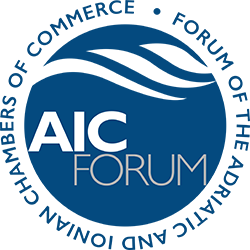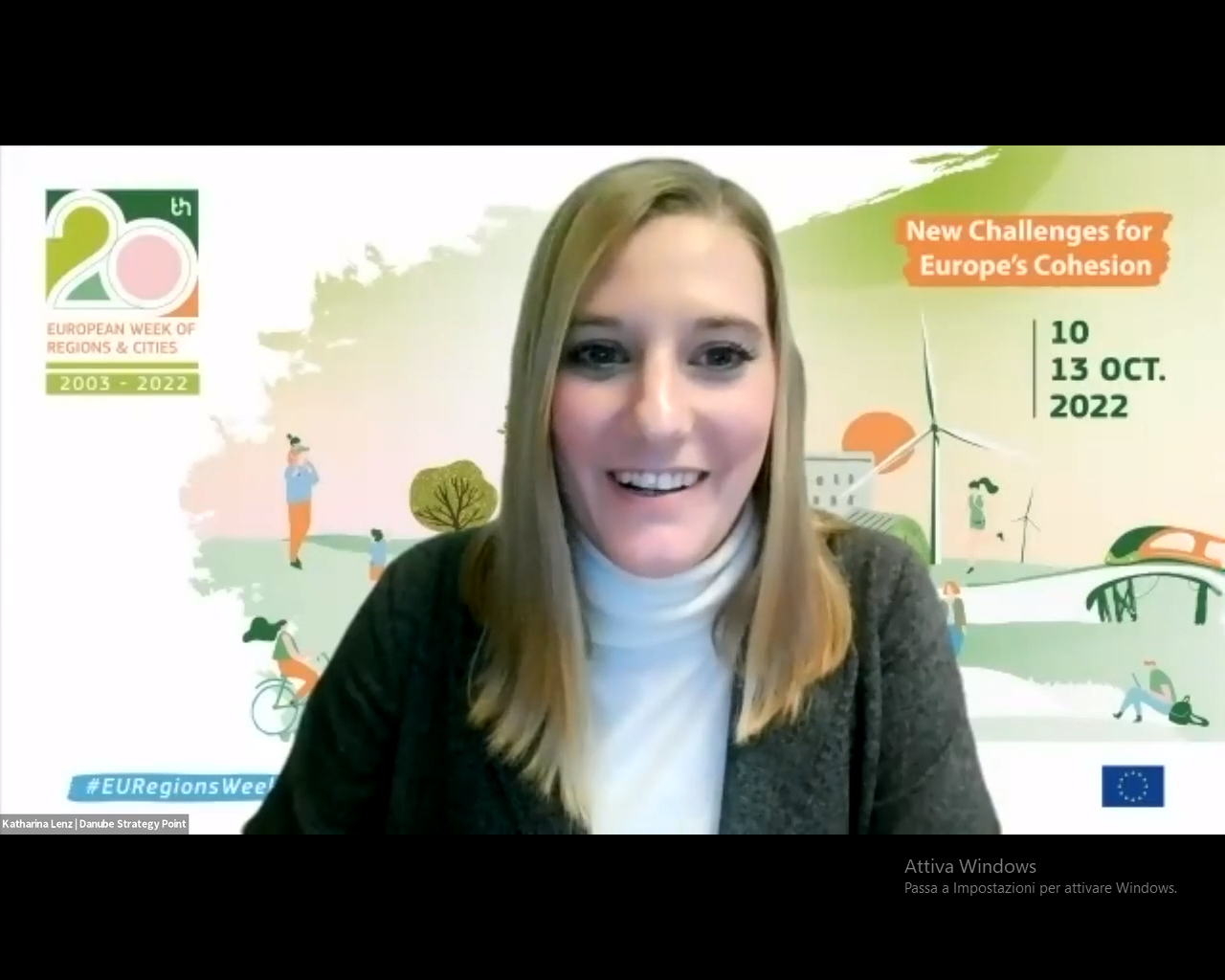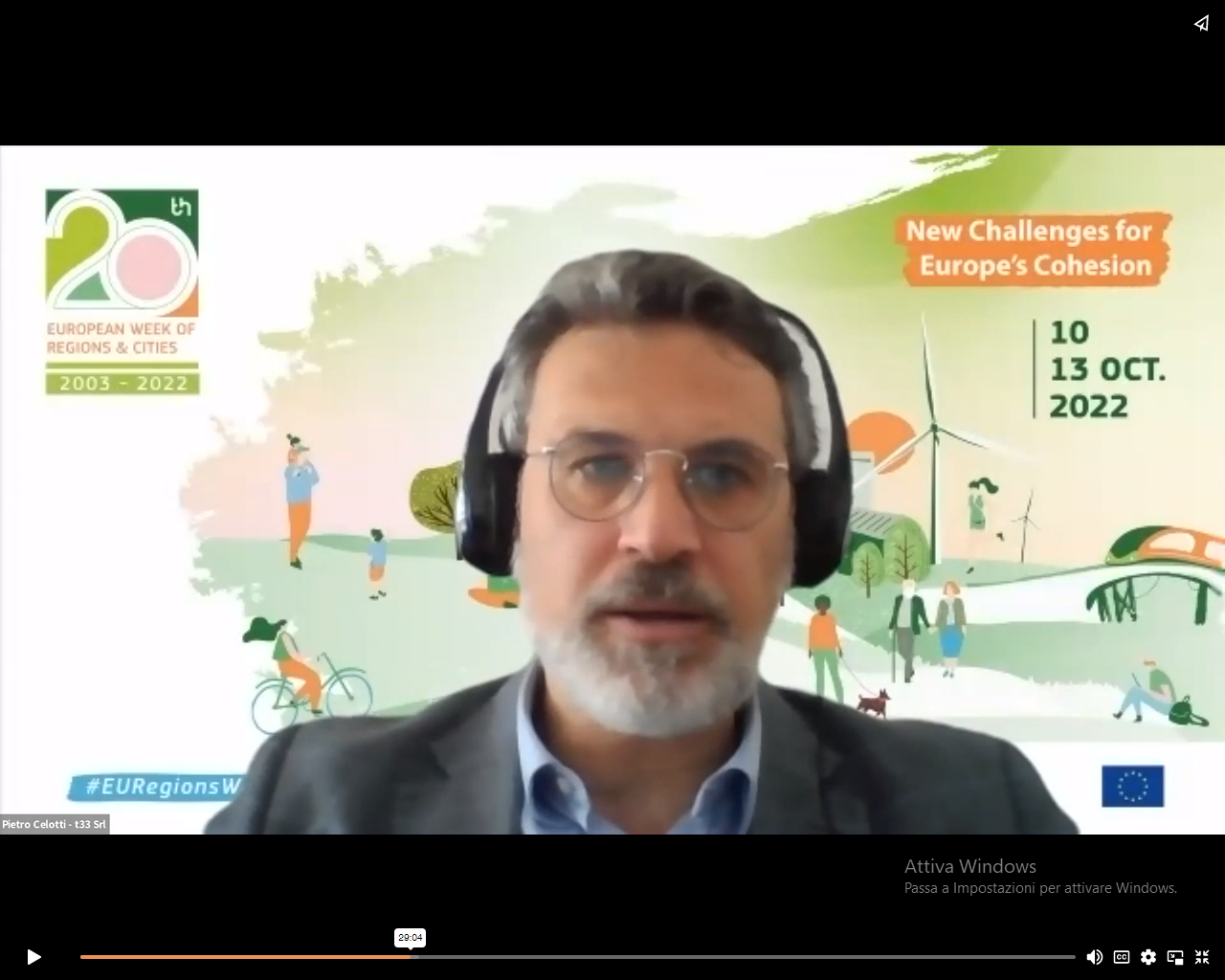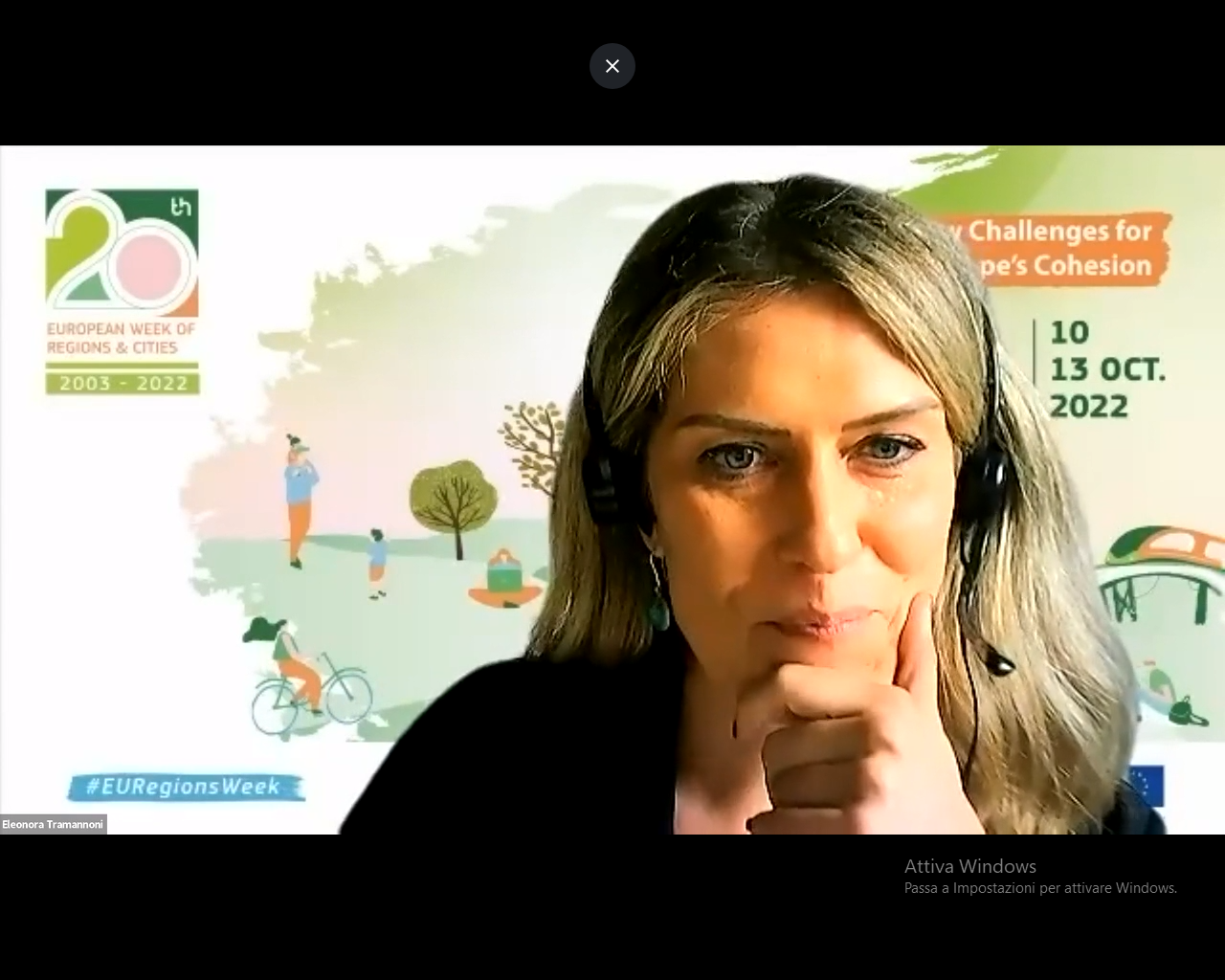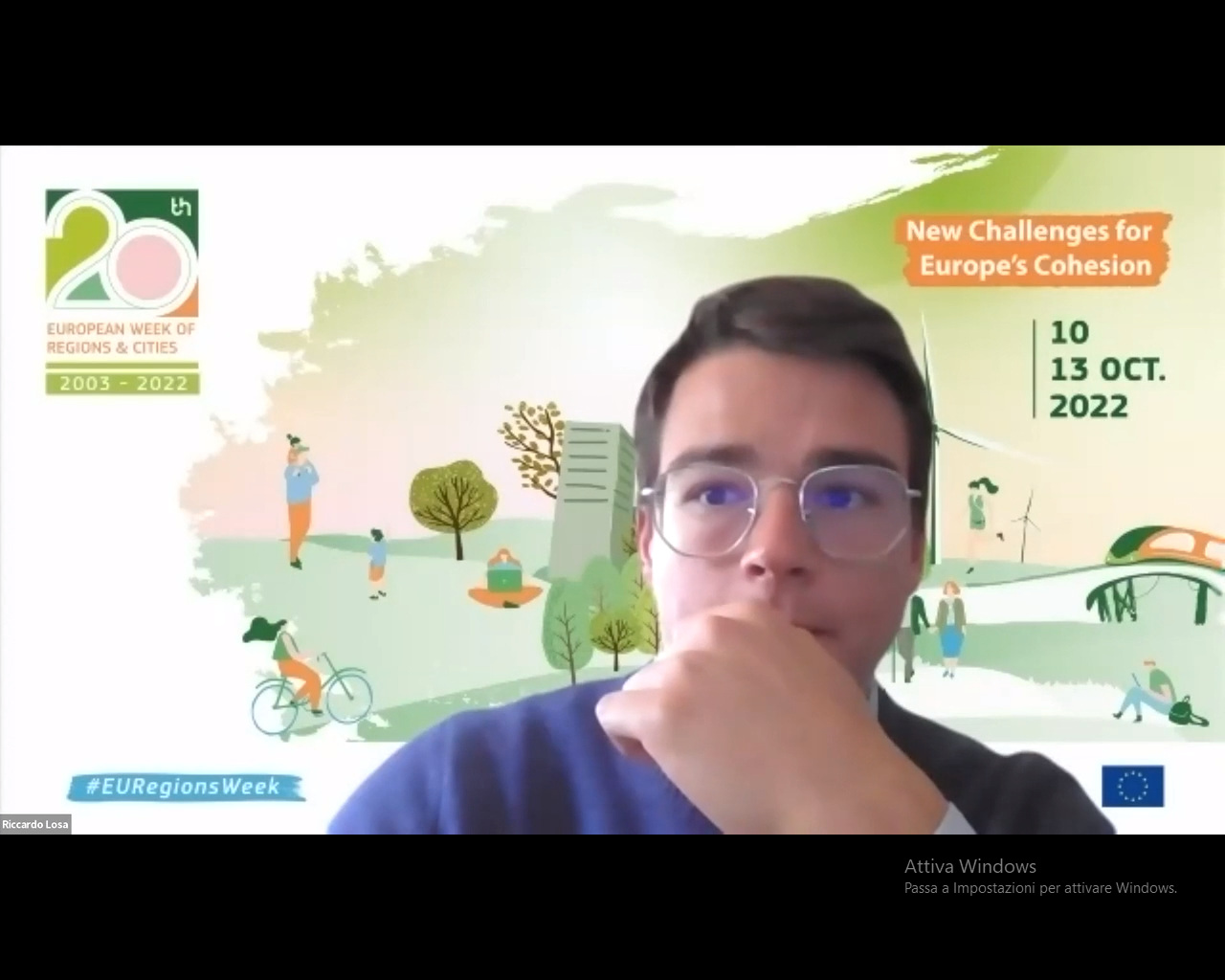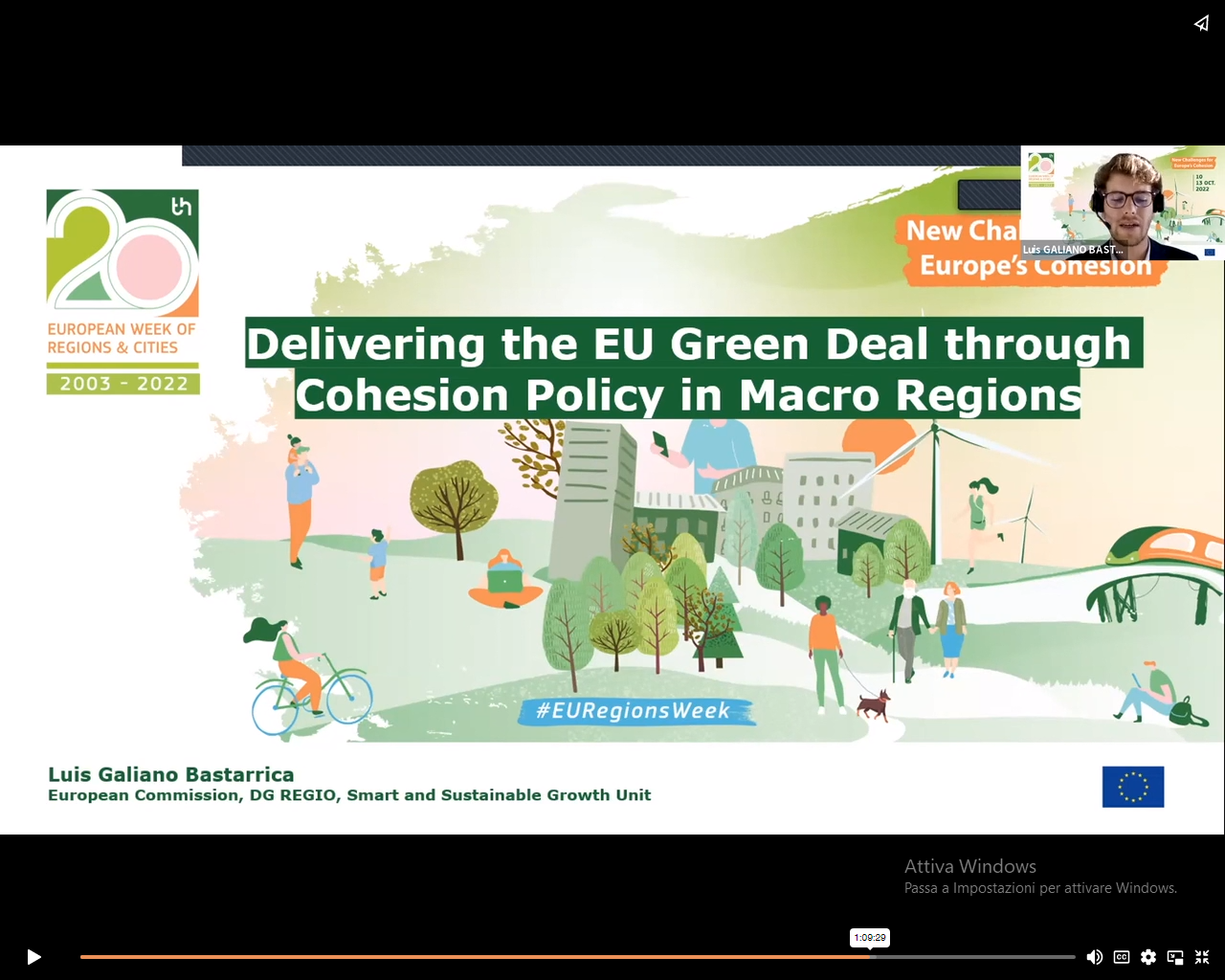In the framework of the European Week of Regions and Cities, The Forum of the Adriatic and Ionian Chambers of Commerce, in collaboration with Uniadrion, organised the Event “Bringing the Green Deal to the EU’s Macroregions”, that was held on the 11th of October 2022, online.
There is considerable reciprocity between the EU Macroregions and the Green Deal: while macroregions support the implementation of the EU Green Deal in a transnational context, the EU Green Deal provides them with a common vision.
Meetings and events are the places where the implementers and stakeholders of EU Macroregions (EU Strategies for the Adriatic-Ionian Region – EUSAIR; the Alpine Region – EUSALP; the Danube Region – EUSDR and the Baltic Sea Region – EUSBSR) build their common vision and reach agreements to achieve the Action Plans’ objectives. Although meetings and events are crucial for multi-level governance, they nevertheless produce significant impacts in terms of both waste creation and carbon footprints. Thus, reducing their negative environmental impacts is the very first step in promoting the shift towards more sustainable practices and behaviours throughout each region.
The best practice “EUSAIR – Bringing the Green Deal to the Region”, promoted by DG Regio and coordinated by the Forum of the Adriatic and Ionian Chambers of Commerce, supports the EUSAIR community’s green transformation with both a strategy and practical tools. This workshop aimed to explore opportunities for applying this strategy to other EU Macroregions.
Moderating the debate was Ms. Eleonora Tramannoni, Executive Officer of the Forum of the Adriatic and Ionian Chambers of Commerce, who gave the participants a background on Forum AIC association and the other 2 organisations of the Civil Society of the same Area – UniAdrion – the Forum of Universities and FAIC, the Forum of the Cities – recognized as one of the major stakeholders of the European Strategy for the Adriatic and Ionian Region, the so-called EUSAIR. She then focused on the meaning of the European macro-regional strategies concept.
A macro-regional strategy is a policy framework which allows countries located in the same region to jointly tackle and find solutions to problems or to better use the potential they have in common. By doing so, they benefit from strengthened cooperation, with the aim of making their policies more efficient than if they had addressed the issues in isolation. An EU macro regional strategy can be supported by EU funds, including the European Structural and Investment Funds at national levels.
Following the European Council request, the strategies are drafted and adopted by the European Commission; but it is important to point out that the process is as important as the result: it must be inclusive and bottom up to ensure ownership – for this reason , the real implementers of the strategies are the stakeholders.
To date, four EU macro-regional strategies have been adopted; each is accompanied by a rolling action plan to be updated regularly in light of new, emerging needs and changing context: the EU Strategy for the Baltic Sea Region (2009); the EU Strategy for the Danube Region (2010); the EU Strategy for the Adriatic and Ionian Region (2014); and the EU Strategy for the Alpine Region (2015).
The aim of this workshop was to give an overview of the European policy context and strategic environmental management; to present the project “EUSAIR bringing the Green Deal to the Region” (financed by DG Regio, coordinated by the Forum in partnership with the company t33 and the University of Padua) and related indicator system and tool; to discover the priorities of the EU Strategy for the Danube Region related to the implementation of the Green Deal; and to learn how to deliver the EU Green Deal through Cohesion Policy in Macro Regions.
The first speaker of the workshop was Riccardo Losa from the University of Padua, among the leading experts in Strategic Environmental Management and Green Public Procurement. He stressed the importance of acting for the environment, by considering environmental issues in our daily life, and most importantly the key role of public administrations in the improvement of sustainability performances of our working activities. He informed the participants that our planet has boundaries and limits that we have already overcome; therefore there is an urge for crucial actions. The most important environmental impact at the moment is related to climate change, with the risk of temperature augmentation of 1.5 degrees, which will lead to dramatic implications. The Sustainable Development Goals (SDGs) are a good way to fight against those dramatic environmental impacts; in particular the target 12.7, that supports public administrations in being more sustainable, by promoting sustainable public procurement practices. Europe is in fact at the forefront of sustainability processes with the publication of two policies: the Integrated Product Policy and the Sustainable Production and Consumption Policy, that have the objective of creating welfare and promoting well-being in our everyday life, but at the same time safeguarding the environment by establishing directive incentives and agreements in the market in order to make the stakeholders and major actors move towards more sustainable practices.
In 2008, Green Public Procurement (GPP) was published. It is a voluntary instrument that supports companies in putting on the market more sustainable goods and services. Its principles are: Life Cycle Thinking: look at products and organisations in a life cycle perspective from cradle to grave perspective to avoid the shift of potential impacts among life cycle stages; Comprehensiveness: look at all of the potential relevant impacts to avoid the shift between environmental impact categories; System approach: consider the product system and the actual and potential conditions under which the product is actually used and managed; Environmentally conscious Design Phase: to plan all the lifecycle and consider all the potential environmental impacts event before the product is put into the market. The main actors that are contributing to the situation are mostly producers and us, consumers; and consequently, we are the ones who can actually take concrete actions to change the situation.
He then focused on the project “Bringing the Green Deal to the Region”, by reminding its main goal, that is to encourage EUSAIR and its stakeholders to act more sustainably in their work and everyday life. The focus was oriented on Events, because they are essential to share expertise and experiences, but everyone can be an active actor in this environmental transformation and this project produced GUIDELINES on how to make thoughtful decisions while organising an event, and TOOLS to measure and monitor the outcomes.
The second speaker was Mr. Pietro Celotti, Policy Analyst at T33, who illustrated the methodology of the environmental indicators system proposed to the EUSAIR governance to measure its contribution to the EU climate targets, and introduced the Guidelines and monitoring tool. The EUSAIR had the chance to implement and develop a model that helps bring the GD to the region and is highly replicable. Indicators were put in place, in order to help measure the reduction of the carbon and environmental footprint of EUSAIR meetings and events.
The INDICATORS are divided in:
Input: the ratio between public expenses for GPP, and total expenses for Public Procurement;
Process: number of procedures according to EU GPP which are published and implemented
Output: it measures the type of events; eg. in presence or online, national or non national participants, number of events, number of days of events, with a focus on hybrid organisation;
Direct result: it measures the amount of greenhouse emissions those events produce, which key point is the choice of transport;
Context: it ties all of the others together, comparing the general result indicator with the general framework we have.
What is needed from now on are Capacity building actions in Candidate and Potential Candidate Countries to adopt GPP and the Implementation of a structured system of data collection and monitoring starting from the year 2022. The Guidelines are useful in that sense, since they help us understand how to make meetings and events more sustainable by applying GPP in their organisation, communication and of course monitoring.
The next speaker was Ms. Katharina Lenz, Policy Officer at Danube Strategy Point of the European Strategy for the Danube Region (EUSDR), who focused on the priorities related to the implementation of the Green Deal; on actions already carried out, on those in progress and on future perspectives. The Danube Region Strategy addresses a wide range of issues; these are divided among 4 pillars and 12 priority areas. Each priority area is managed by two countries as Priority Area Coordinators (PACs). She mentioned the EUSDR Action Plan implemented in 2020 (SWD(2020) 59 final), that helped to achieve a better compatibility of the defined Actions and targets with programmes and funding instruments. This allows a targeted embedding into the programmes’ objectives and to define potential synergies and complementarities.
The core EUSDR stakeholders agreed on a shortlist of concise strategic topics, providing a consolidated and concise guidance for ‘project pipelines’ (Danube Strategy Flagships).
A EUSDR Policy/Impact Evaluation was conducted and published in 2022, which highlighted that the potential contribution of the EUSDR to the objectives of the EU Green Deal is high and refers to two impact areas: green transition at national level through facilitating coordination in decision-making and action, cross-sectoral approaches, multi-level governance and stakeholder involvement; to transfer the EGD priorities and objectives to non-EU countries in the Danube Region, in line with the role of EUSDR in European integration.
Within the strategy, flagships were recently published, which are projects or processes that contribute to the implementation of the EU Strategy for the Danube Region, and have a clear macro-regional dimension and a multi-level governance approach. They contribute to strengthening internal and external communication of the Strategy and the visibility of the topics, initiatives and prospects in the Danube Region. She then gave some insights on 2 flagships: Diversification of gas supply in EUSDR (PA 2), which commissioned a study on how to reduce gas import independence in the Danube Region; and the Western Balkans R&I Information Hub, which is provided by the Horizon Europe project POLICY ANSWERS, and deploys a vast array of tools to support a better integration of the WB into the European Research Area.
Ms. Tramannoni then asked a question to Ms. Lenz: Since the EUSDR and EUSAIR Strategies share a considerable number of countries, both EU countries such as Croatia and Slovenia, and Western Balkans – Bosnia-Herzegovina, Montenegro and Serbia – in your opinion, how is it possible to better coordinate and cooperate in order to achieve the objectives of the EGD?
Ms. Lenz’s answer focused on the possible dialogue of National Coordination Levels and the thematic coordination level which can be a good opportunity to exchange and to implement the EGD together; there are many ways in which that can be done: Priority Areas, Thematic Areas, Steering Groups, Working Groups. Youth of course is also very important, to be able to hear from the next generations about the important topics that were addressed during this meeting.
The last speaker of the workshop was Mr. Luis Galiano Bastarrica, Policy Assistant on climate and energy policies of European Commission | DG Regio – Unit G1 “Smart and Sustainable Growth”, who focused on how to deliver the EU Green Deal through Cohesion Policy in Macro Regions. Due to the many challenges we are confronted with today, the EU proposed a compass, or guiding direction, to which all the policies should be oriented, which is the EU Green Deal. DG Regio deals with Cohesion policies which play a crucial role in supporting the regions to keep up with transformations and innovations.
The main four objectives of DG Regio are: Investing in place-based innovation and smart economic transformation; Deploying technological and social innovation on a large scale; Facilitating phase-out of unsustainable practices, ensuring a just transition for all regions.
Of course, in order for these goals to be met, cooperation is a key element, by exchanging information, sharing good practices and experiences; involving all relevant stakeholders in the preparation and implementation of cohesion policy programmes.
With regard to the financial period 2021-2027, at least 30% of the ERDF and 37% of the CF is to be dedicated to climate action. The policy objectives for this period are 5:
- A more competitive and smarter Europe
- A greener, low-carbon transitioning towards a net zero carbon economy and resilient Europe
- A more connected Europe
- A more social and inclusive Europe
- A Europe closer to citizens.
In particular, Policy Objective2 has its specific objectives, among those: energy efficiency and promotion of renewable energy, disaster risk management, sustainable water management, circular and resource-efficient economy, biodiversity protection and reduction of all forms of pollution.
The European Commission is aware of the utility and necessity of sustainability transition and therefore the Toolkit for Sustainability Transitions was developed, in order to support Macro-Regions beyond funding in achieving the goals of the European Green Deal.
To conclude, he mentioned the new project implemented by DG Regio, “The Cohesions4Transitions (C4T) Platform” that will provide detailed technical assistance to Managing Authorities to make best use of ERDF PO2 funding.
Ms. Tramannoni then asked Ms. Lenz and Mr. Galiano Bastarrica their opinions on the Guidelines and monitoring tools developed in the “Bringing the Green Deal to the EUSAIR” project.
Mr. Galiano Bastarrica affirmed that they’re really relevant since they allow for traceability and accountability; being important to monitor events and meetings that will take place in the future. Ms. Lenz observed that having guidelines and a monitoring tool ready to use is a great help, since we could already start to use it and propose it to stakeholders. A target group for this dissemination could be, once again, young people, since, as Ms’ Lenz already mentioned, they manifested a great interest in the topic and their point of view could be brought into the conversation.
For this session, the SLIDO app was active, in which participants were asked to answer some multiple choice questions related to the intervention of the speakers and their personal experience. Here are the results of the polls.
